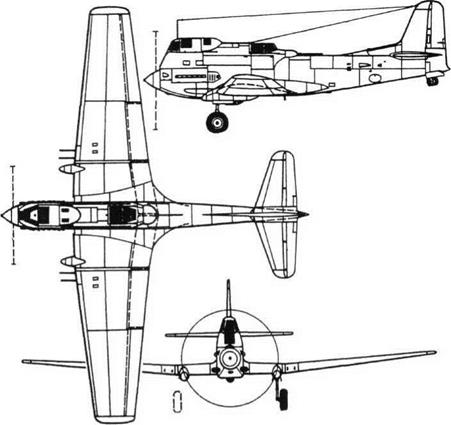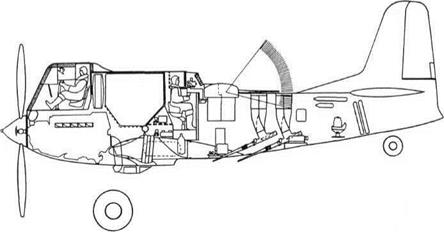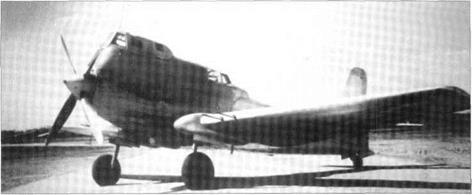Ilyushin IL-20
Purpose: To design an improved Shturmovik attack aircraft.
Design Bureau: OKB of Sergei Ilyushin, Moscow.
In the Great Patriotic War Ilyushin became famous, even outside the Soviet Union, mainly because of his IL-2 Shturmovik (assaulter). No fewer than 36,163 were delivered, the greatest production run of any single type of aircraft. One reason why so many were needed was that attrition was severe, despite their heavy armour. With the IL-10M Ilyushin fractionally improved flight performance, and by 1945 the availability of more powerful engines opened the way to a further increase in gross weight. In turn this made it possible to rethink the armament, in particular adding a more effective rear defence. The single IL-20 – dubbed Gorboon, hunchback – began flight testing in 1948, but by this time piston-engined aircraft for front-line use were becoming outdated. Ilyushin dropped the IL-20 and began work on the IL-40 twin-jet Shturmovik, as well as jet bombers and other types.



 The IL-20 was a direct extrapolation of the IL-10 and related types, with similar all-metal stressed-skin construction. A basic shortcoming of the wartime Shturmoviks had been that, in most low-level attacks with bombs, the target disappeared under the nose before the bombs could be released. Ilyushin had spent much time trying to devise ways of giving the pilot a better forward view. In 1942 he had tried putting the pilot in the nose, with a shaft drive from an engine behind the cockpit, but dropped this idea. Various laboratories also failed to find good answers, one being the PSh periscopic sight. In 1946 he tried the even more unusual scheme of putting the pilot directly above the engine. The latter was an AM-47F (also called MF-47) liquid-cooled V-12, the last of Mikulin’s big piston engines, rated at 3,100hp, driving a 3.2m (10ft 6in) four-blade propeller. Despite being protected below by armour and with the cockpit above, the engine was said to be readily accessible and removable. The pilot had a cockpit with armour 6 to 9mm thick, with a field of view directly ahead up to 37° downwards, so that in a shallow dive he had a perfect view of the target. Behind the cockpit was a large protected tank, and behind that a radio operator in a powered turret with an NR-23 cannon. The main landing gears retracted aft in the usual manner, the wheels rotating 90° to lie flat in the wings. Immediately outboard of these were four NS-23 cannon firing ahead. In one scheme; illustrated on this page, two further NS-23 were fixed obliquely in the rear fuselage firing ahead and
The IL-20 was a direct extrapolation of the IL-10 and related types, with similar all-metal stressed-skin construction. A basic shortcoming of the wartime Shturmoviks had been that, in most low-level attacks with bombs, the target disappeared under the nose before the bombs could be released. Ilyushin had spent much time trying to devise ways of giving the pilot a better forward view. In 1942 he had tried putting the pilot in the nose, with a shaft drive from an engine behind the cockpit, but dropped this idea. Various laboratories also failed to find good answers, one being the PSh periscopic sight. In 1946 he tried the even more unusual scheme of putting the pilot directly above the engine. The latter was an AM-47F (also called MF-47) liquid-cooled V-12, the last of Mikulin’s big piston engines, rated at 3,100hp, driving a 3.2m (10ft 6in) four-blade propeller. Despite being protected below by armour and with the cockpit above, the engine was said to be readily accessible and removable. The pilot had a cockpit with armour 6 to 9mm thick, with a field of view directly ahead up to 37° downwards, so that in a shallow dive he had a perfect view of the target. Behind the cockpit was a large protected tank, and behind that a radio operator in a powered turret with an NR-23 cannon. The main landing gears retracted aft in the usual manner, the wheels rotating 90° to lie flat in the wings. Immediately outboard of these were four NS-23 cannon firing ahead. In one scheme; illustrated on this page, two further NS-23 were fixed obliquely in the rear fuselage firing ahead and

downwards. A bomb load of up to 1,190kg (2,623.5 Ib) could be carried in wing cells, and wing racks were provided for eight RS-82 or four RS-132 rockets. There was also to have been an anti-submarine version, never built.
Though clearly a formidable aircraft, the IL-20 actually had a flight performance in almost all respects inferior to that of the wartime IL-10. Ilyushin was certainly right to abandon it, and in fact the basic attack role was later assumed by the simple MiG-15 single-seat fast jet.
|
||||||||||||||||||||||||||||||||||||||||||||||||||||||||||||
|
||||||||||||||||||||||||||||||||||||||||||||||||||||||||||||
|
|










